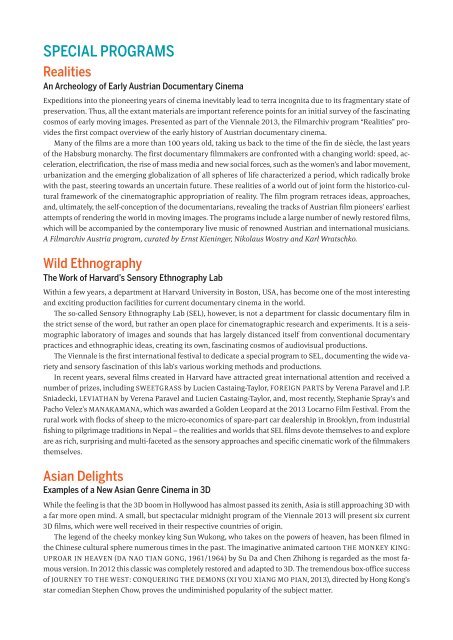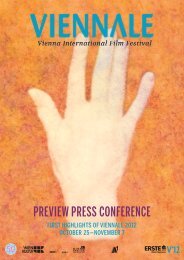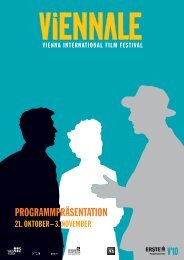Download press kit here - Viennale
Download press kit here - Viennale
Download press kit here - Viennale
You also want an ePaper? Increase the reach of your titles
YUMPU automatically turns print PDFs into web optimized ePapers that Google loves.
SPECIAL PROGRAMS<br />
Realities<br />
An Archeology of Early Austrian Documentary Cinema<br />
Expeditions into the pioneering years of cinema inevitably lead to terra incognita due to its fragmentary state of<br />
preservation. Thus, all the extant materials are important reference points for an initial survey of the fascinating<br />
cosmos of early moving images. Presented as part of the <strong>Viennale</strong> 2013, the Filmarchiv program “Realities” provides<br />
the first compact overview of the early history of Austrian documentary cinema.<br />
Many of the films are a more than 100 years old, taking us back to the time of the fin de siècle, the last years<br />
of the Habsburg monarchy. The first documentary filmmakers are confronted with a changing world: speed, acceleration,<br />
electrification, the rise of mass media and new social forces, such as the women’s and labor movement,<br />
urbanization and the emerging globalization of all sp<strong>here</strong>s of life characterized a period, which radically broke<br />
with the past, steering towards an uncertain future. These realities of a world out of joint form the historico-cultural<br />
framework of the cinematographic appropriation of reality. The film program retraces ideas, approaches,<br />
and, ultimately, the self-conception of the documentarians, revealing the tracks of Austrian film pioneers’ earliest<br />
attempts of rendering the world in moving images. The programs include a large number of newly restored films,<br />
which will be accompanied by the contemporary live music of renowned Austrian and international musicians.<br />
A Filmarchiv Austria program, curated by Ernst Kieninger, Nikolaus Wostry and Karl Wratschko.<br />
Wild Ethnography<br />
The Work of Harvard’s Sensory Ethnography Lab<br />
Within a few years, a department at Harvard University in Boston, USA, has become one of the most interesting<br />
and exciting production facilities for current documentary cinema in the world.<br />
The so-called Sensory Ethnography Lab (SEL), however, is not a department for classic documentary film in<br />
the strict sense of the word, but rather an open place for cinematographic research and experiments. It is a seismographic<br />
laboratory of images and sounds that has largely distanced itself from conventional documentary<br />
practices and ethnographic ideas, creating its own, fascinating cosmos of audiovisual productions.<br />
The <strong>Viennale</strong> is the first international festival to dedicate a special program to SEL, documenting the wide variety<br />
and sensory fascination of this lab’s various working methods and productions.<br />
In recent years, several films created in Harvard have attracted great international attention and received a<br />
number of prizes, including SWEETGRASS by Lucien Castaing-Taylor, FOREIGN PARTS by Verena Paravel and J.P.<br />
Sniadecki, LEVIATHAN by Verena Paravel and Lucien Castaing-Taylor, and, most recently, Stephanie Spray’s and<br />
Pacho Velez’s MANAKAMANA, which was awarded a Golden Leopard at the 2013 Locarno Film Festival. From the<br />
rural work with flocks of sheep to the micro-economics of spare-part car dealership in Brooklyn, from industrial<br />
fishing to pilgrimage traditions in Nepal – the realities and worlds that SEL films devote themselves to and explore<br />
are as rich, surprising and multi-faceted as the sensory approaches and specific cinematic work of the filmmakers<br />
themselves.<br />
Asian Delights<br />
Examples of a New Asian Genre Cinema in 3D<br />
While the feeling is that the 3D boom in Hollywood has almost passed its zenith, Asia is still approaching 3D with<br />
a far more open mind. A small, but spectacular midnight program of the <strong>Viennale</strong> 2013 will present six current<br />
3D films, which were well received in their respective countries of origin.<br />
The legend of the cheeky monkey king Sun Wukong, who takes on the powers of heaven, has been filmed in<br />
the Chinese cultural sp<strong>here</strong> numerous times in the past. The imaginative animated cartoon THE MONKEY KING:<br />
UPROAR IN HEAVEN (DA NAO TIAN GONG, 1961/1964) by Su Da and Chen Zhihong is regarded as the most famous<br />
version. In 2012 this classic was completely restored and adapted to 3D. The tremendous box-office success<br />
of JOURNEY TO THE WEST: CONQUERING THE DEMONS (XI YOU XIANG MO PIAN, 2013), directed by Hong Kong’s<br />
star comedian Stephen Chow, proves the undiminished popularity of the subject matter.




